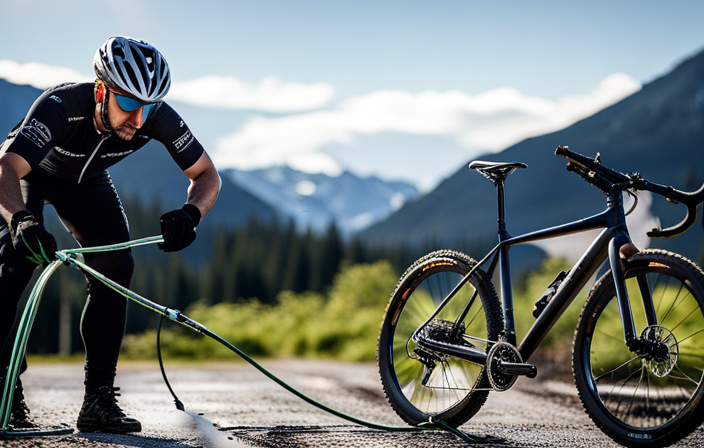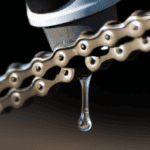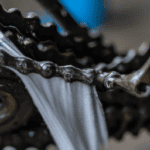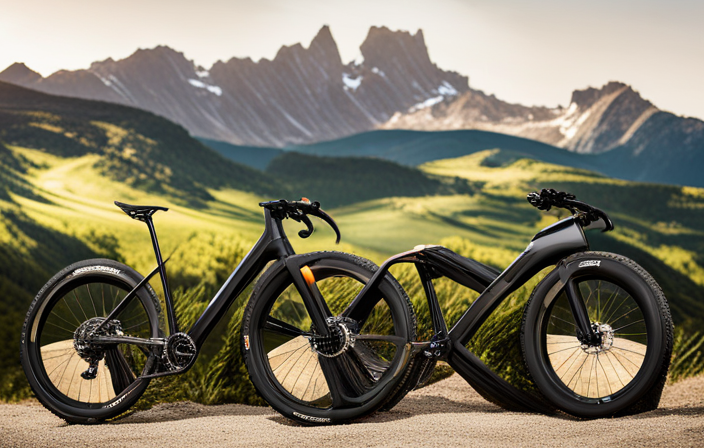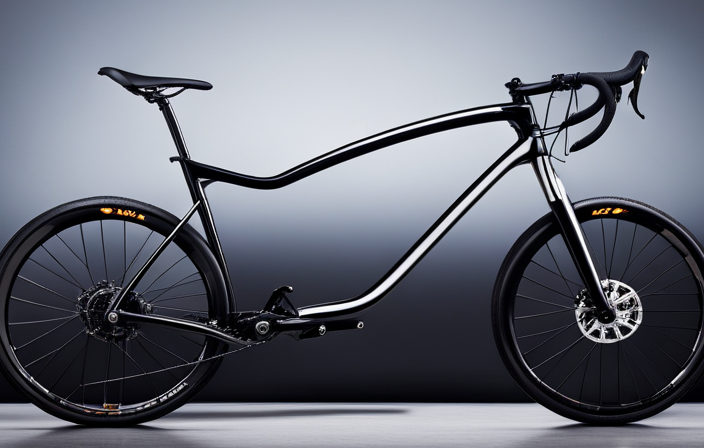Cleaning a gravel bike is akin to providing it with a refreshing spa experience. Similar to how we engage in self-care practices to rejuvenate ourselves, our bicycles too need a bit of tender love and care to ensure they perform at their best and last longer.
In this article, I will guide you through the step-by-step process of cleaning your gravel bike with expert precision. From gathering the necessary supplies to reassembling and adjusting the bike, I’ll provide detailed instructions to ensure your trusty steed sparkles like new after every ride.
Get ready to pamper your gravel bike and keep it in top shape!
Key Takeaways
- Gather the necessary cleaning supplies, including a bucket, hose with spray nozzle, soft brush or sponge, bike-specific cleaner or mild soap, and degreaser.
- Follow proper storage methods to maintain bike longevity, such as storing in a dry and cool area away from direct sunlight, using a sturdy bike rack or wall mount, and protecting from potential accidents.
- Follow a thorough cleaning process, including pre-rinsing with moderate water pressure, removing dirt and debris from the frame, cleaning the wheels and tires, scrubbing the drivetrain components, using a brush to clean the brakes, drying and polishing the bike, and lubricating the chain and moving parts.
- Choose the right brush for brake cleaning, with stiff bristles to prevent wear and tear, an angled head for tight spaces, the ability to remove dirt and grime from brake calipers and pads, and the ability to remove residue from the rim surface.
Gather the Necessary Cleaning Supplies
You’ll need to gather the necessary cleaning supplies for cleaning your gravel bike. Start by collecting a bucket, a hose with a spray nozzle, a soft brush or sponge, bike-specific cleaner or mild soap, degreaser, chain lubricant, and a microfiber cloth.
Cleaning techniques are crucial to ensure that your bike stays in top shape and performs at its best on every ride. Proper storage methods are also essential for maintaining the longevity of your bike. To prevent rust and damage, store your gravel bike in a dry and cool area away from direct sunlight. Consider using a sturdy bike rack or wall mount to keep it off the ground and protect it from potential accidents.
Now that you have all the necessary supplies gathered, it’s time to start with a pre-rinse. This step is important because it removes loose dirt and grime before applying any cleaning agents. Simply use the hose with the spray nozzle attachment to thoroughly rinse your gravel bike from top to bottom. Once complete, you can move on to the next step of cleaning: washing and scrubbing away stubborn dirt and grease.
Start with a Pre-Rinse
To begin, give the gravel bike a thorough pre-rinse. Pre-rinsing is an essential step in cleaning your bike as it helps to remove loose dirt and debris before applying any cleaning products. This ensures that the subsequent steps are more effective and efficient in getting your bike sparkling clean.
Here are some pre-rinse techniques you can follow:
- Use a hose with moderate water pressure to gently spray off any loose dirt and mud from the frame, wheels, and drivetrain.
- Pay special attention to hard-to-reach areas like the bottom bracket, fork crown, and chainstays by using a nozzle attachment or a narrow jet of water.
- Avoid using high-pressure washers as they can force water into sensitive components such as bearings and seals.
Benefits of pre-rinsing include preventing scratches caused by rubbing dirt particles against the frame during cleaning and reducing the amount of grime that needs to be scrubbed off later.
Now that we’ve completed the pre-rinse, let’s move on to removing dirt and debris from the frame without causing any damage.
Remove Dirt and Debris from the Frame
Start by gently brushing away any dirt or debris from the frame using a soft-bristled brush. This will help to loosen and remove any loose particles that may be stuck on the surface. Make sure to pay attention to hard-to-reach areas such as the bottom bracket, chainstays, and seat tube.
Once you have removed the larger dirt particles, it’s time to move on to cleaning techniques specifically designed for bike frames.
There are various cleaning products available in the market that are specifically formulated for bike frames. These products are usually mild and safe to use on different bike materials such as aluminum, carbon fiber, or steel. Follow the instructions provided by the manufacturer when applying these products to ensure effective cleaning without causing any damage.
When using cleaning products, it is important to avoid getting them near sensitive components like bearings or drivetrain parts. Use a clean cloth or sponge dampened with water and mild soap to gently wipe down the frame, removing any remaining dirt or grime.
Once you have thoroughly cleaned the frame, it’s time to move on to cleaning the wheels and tires. Transitioning into this next section of bike maintenance involves ensuring that all parts of your gravel bike are sparkling clean and ready for your next adventure on rough terrain.
Clean the Wheels and Tires
Moving on to the next step, it’s important to ensure that the wheels and tires of your gravel bike are also properly maintained. Cleaning techniques for these components will not only keep them looking good but also improve their performance and longevity. Regularly cleaning your wheels and tires should be included in your maintenance schedule.
To clean your wheels and tires effectively, follow these steps:
- Start by removing any excess dirt or mud with a soft brush or cloth.
- Use a mild soap solution or specialized bike cleaner to gently scrub the rims, spokes, and hub surfaces. Pay extra attention to areas where dirt tends to accumulate.
- Rinse thoroughly with water, making sure to remove all traces of soap or cleaner.
- Dry the wheels using a clean towel or air-drying them naturally.
- Once dry, inspect for any signs of damage such as loose spokes or worn-out tread on the tires.
Regularly cleaning your wheels and tires not only enhances their appearance but also ensures optimal performance.
Now we can move on to the subsequent section about scrubbing the drivetrain components without compromising their functionality.
Scrub the Drivetrain Components
Once you’ve finished cleaning the wheels and tires, it’s time to scrub the drivetrain components to ensure their optimal performance. The drivetrain is a crucial part of your gravel bike that includes the chain, cassette, and derailleur. Cleaning these components regularly will not only extend their lifespan but also contribute to smoother shifting and better overall performance.
To effectively clean the drivetrain, you’ll need some essential cleaning techniques and recommended cleaning products. Firstly, use a degreaser to remove any built-up grime on the chain and cassette. Apply the degreaser generously and let it sit for a few minutes before scrubbing with a stiff brush or toothbrush. Make sure to reach all the nooks and crannies for thorough cleaning.
Next, rinse off the degreaser using water or a bike-specific cleaner. Be careful not to use excessive water pressure as it can damage delicate parts of your drivetrain. After rinsing, dry off the components with a clean cloth or towel.
Incorporating a regular maintenance routine using these cleaning techniques will keep your drivetrain in excellent condition for longer rides ahead. Moving forward, we’ll pay attention to the chain and cassette as they require specific care for optimal function without skipping gears or causing unnecessary wear and tear."
Pay Attention to the Chain and Cassette
After thoroughly scrubbing the drivetrain components, it’s time to focus on the chain and cassette. These two parts are crucial for smooth shifting and efficient power transfer, so proper cleaning techniques are essential for optimal bike maintenance.
To begin, I recommend using a degreaser specifically designed for bicycles. Apply the degreaser to the chain and cassette, making sure to cover all the teeth and links. Let it sit for a few minutes to break down any grime or grease buildup.
Next, take a stiff brush and start scrubbing the chain. Move the brush along each link, paying extra attention to the rollers where dirt tends to accumulate. Make sure to rotate your pedals backwards as you go, allowing you to clean every part of the chain thoroughly.
Once you’ve cleaned the chain, move on to the cassette. Use a smaller brush or even an old toothbrush to reach between each cog and remove any debris that may be lodged there.
By properly cleaning your bike’s chain and cassette with these techniques, you’ll ensure they remain in top condition for longer periods of time.
Now that we’ve covered this aspect of gravel bike maintenance, let’s move on to another important step: using a brush to clean the brakes…
Use a Brush to Clean the Brakes
To clean the brakes effectively, you’ll want to use a brush that can reach into all the nooks and crannies. When it comes to brush maintenance, it’s important to choose a brush with stiff bristles that won’t easily wear down. A brush with an angled head is particularly useful for getting into tight spaces around the brake calipers and pads.
Here are three essential brake cleaning techniques using a brush:
-
Start by gently brushing the brake calipers to remove any dirt or grime that may have accumulated. Pay close attention to areas where debris tends to build up, such as between the brake arms and around the mounting bolts.
-
Next, carefully clean the brake pads using short, firm strokes of the brush. This will help dislodge any embedded particles that could impair braking performance. Be sure to clean both sides of each brake pad thoroughly.
-
Finally, take your time and clean the rim surface where the brake pads make contact. Use long sweeping motions with moderate pressure to remove any residue or contaminants that could compromise braking efficiency.
Once you’ve finished cleaning the brakes, it’s time to move on to rinsing the bike thoroughly in order to remove any remaining soap or cleaning solution from all its components.
Rinse the Bike Thoroughly
Make sure to thoroughly rinse the bicycle to remove any remaining soap or cleaning solution from all its components. This step is crucial in maintaining the longevity of your gravel bike and preventing rust. Regularly cleaning your bike is important because it helps remove dirt, grime, and other contaminants that can wear down the parts over time. It also allows you to inspect your bike for any potential issues or damage that may need attention.
To effectively rinse your bike, use a hose with moderate water pressure. Start at the top and work your way down, ensuring that every part gets cleaned. Pay close attention to hard-to-reach areas like the bottom bracket and chainstay junctions. A thorough rinse will help wash away any residue left behind by the cleaning products.
For added depth, here’s a table showcasing some useful tips for preventing rust on your gravel bike:
| Tip | Description |
|---|---|
| Keep your bike dry | After each ride or wash, make sure to dry off your gravel bike completely using a clean cloth or towel. Moisture can accelerate rust formation on metal parts. |
| Apply a protective coating | Consider applying a layer of wax or corrosion inhibitor spray on exposed metal surfaces to provide an extra barrier against moisture and oxidation. |
| Store in a dry place | When not in use, store your gravel bike in a dry environment away from moisture and humidity that can promote rust development. |
By following these tips and regularly rinsing your gravel bike after each ride or washing session, you’ll ensure its longevity while minimizing the risk of rust formation. Now let’s move on to drying the bike properly without wasting any time.
Dry the Bike Properly
Once you have thoroughly rinsed your bicycle, it’s important to ensure that you dry it properly to prevent any moisture from causing rust or damage. Properly drying techniques are crucial in maintaining the longevity of your gravel bike. Here are some key steps to follow:
-
Start by using a clean and soft cloth or towel to gently wipe down the frame and components. Make sure to reach all the nooks and crannies.
-
Next, use compressed air or a blower to remove any remaining water droplets from hard-to-reach areas, such as between gears and brake calipers.
-
Finally, leave your bike in a well-ventilated area or use a fan to speed up the drying process. Avoid leaving it under direct sunlight as excessive heat can damage certain parts.
By taking these steps, you can effectively eliminate moisture and minimize the risk of rust formation on your gravel bike. Remember that rust not only affects the appearance but also compromises the functionality of various components. Once your bike is dry, you can proceed with checking for any potential damage or wear before your next ride.
Transitioning into the subsequent section:
Now that we have ensured proper drying techniques, let’s move on to checking for any damage or wear on our gravel bike.
Check for any Damage or Wear
Now that we’ve dried our bicycle properly, it’s important to check for any signs of damage or wear. Inspecting the bike thoroughly is crucial to ensure its safety and longevity. Start by examining the frame for any cracks, dents, or scratches. These could indicate a structural issue that needs immediate attention. Pay close attention to areas where the frame is joined together, such as welds or carbon fiber joints.
Next, check the wheels for any loose spokes or cracks on the rims. Spin each wheel and listen for any unusual noises or wobbles. It’s also essential to inspect the tires for cuts, bulges, or excessive wear. Replace them if necessary to maintain optimal traction and prevent punctures.
Moving on to the drivetrain, carefully examine the chainrings, cassette, and chain for signs of wear and tear. Look out for worn-out teeth on the chainrings and cassette as well as stretched chains that may need replacement. Lubricate these components regularly to minimize friction and extend their lifespan.
In conclusion, checking your gravel bike for potential damage and signs of wear is an integral part of proper maintenance. By identifying issues early on, you can address them promptly before they escalate into more significant problems.
Now let’s move on to lubricating the chain and moving parts section…
Lubricate the Chain and Moving Parts
To ensure smooth operation and prevent premature wear, it’s important to regularly lubricate your chain and moving parts. Chain maintenance is a crucial aspect of gravel bike care as it not only improves performance but also extends the lifespan of your components. When it comes to lubricating the chain, choosing the right type of lubricant is essential. I recommend using a dry or wet lube depending on the weather conditions you typically ride in. Dry lubes are ideal for dusty environments while wet lubes offer better protection in wet conditions.
When applying the lubricant, make sure to focus on each individual link by rotating the pedals backwards slowly. This ensures that every part of the chain is adequately coated with the lubricant. Additionally, don’t forget to apply some lubricant to other moving parts such as derailleurs and brake pivots.
To help you keep track of your chain maintenance routine, here’s a handy table:
| Maintenance Task | Frequency |
|---|---|
| Lubricate chain | Every 100 miles |
| Clean derailleur pulleys | Every 500 miles |
| Check brake pivot points | Every 200 miles |
| Inspect bottom bracket | Annually |
Regularly lubricating your chain and moving parts will keep them running smoothly and reduce friction, enhancing your overall riding experience. Now that we have ensured proper maintenance, let’s move on to reassembling and adjusting our bike for optimal performance without any further delays
Reassemble and Adjust the Bike
After lubricating the chain and moving parts, it’s time to reassemble and make necessary adjustments for optimal performance. First, I check the bike fit to ensure that everything is in the right place. This includes adjusting the saddle height, handlebar position, and cleat alignment if applicable. Proper bike fit is important for comfort and efficiency during rides.
Next, I troubleshoot common bike issues that may have arisen during disassembly or lubrication. I check the brakes to make sure they are aligned properly and functioning smoothly. I also inspect the gears to ensure smooth shifting without any skipping or chain rub. Additionally, I check the wheels for proper truing and tighten any loose spokes.
Once all adjustments have been made, I give the bike a test ride to ensure everything feels smooth and responsive. If any issues persist, further troubleshooting may be required.
With the reassembly and adjustments complete, it’s time to move on to cleaning and polishing the frame. This step will help maintain the appearance of my gravel bike while also protecting it from corrosion and wear caused by dirt and grime buildup over time.
Clean and Polish the Frame
Once the reassembly and adjustments are complete, it’s important to maintain the appearance and protect the frame by cleaning and polishing it.
Cleaning a gravel bike may seem like a daunting task, but with a few cleaning hacks and the right cleaning products, you can keep your bike looking as good as new.
Start by removing any dirt or debris from the frame using a soft brush or cloth. Pay close attention to hard-to-reach areas such as the bottom bracket and chainstays.
Next, choose a gentle cleaner specifically designed for bikes, avoiding harsh chemicals that can damage the paint or components. Apply the cleaner to a sponge or cloth and gently scrub the frame in circular motions.
Rinse thoroughly with water, making sure to remove all traces of cleaner. To polish the frame, use a high-quality bike polish that will not only restore shine but also protect against future damage.
Apply it evenly across the entire frame using a clean cloth, then buff it off for a smooth finish.
Now that your gravel bike is clean and polished, it’s time to store it in a dry and safe place to prevent any unnecessary wear or damage.
Store the Bike in a Dry and Safe Place
Make sure you find a dry and safe place to store your newly cleaned and polished ride. Proper storage is essential for maintaining the longevity of your gravel bike. Here are three key considerations when choosing the right storage solution:
-
Climate Control: Opt for a storage area that maintains a consistent temperature and humidity level. Fluctuations in temperature and moisture can cause corrosion, rust, or damage to sensitive components.
-
Protection from Elements: Shield your bike from dust, dirt, UV rays, and other environmental factors that can degrade its performance and appearance. A covered storage option such as a garage or shed with adequate ventilation is ideal.
-
Secure Storage: Ensure your bike is stored in a location where it’s protected against theft or accidental damage. Utilize locks or consider investing in a secure bike rack or locker for added peace of mind.
By following these guidelines, you’ll safeguard your investment and prolong the life of your gravel bike.
Now let’s move on to regular maintenance tips for keeping your clean gravel bike performing at its best without compromising safety or performance.
Regular Maintenance Tips for a Clean Gravel Bike
To keep your gravel bike in optimal condition, it’s important to regularly maintain and care for it. Following a regular maintenance schedule is crucial to ensure that your bike stays clean and performs at its best. Here are some key tips for maintaining a clean gravel bike:
| Maintenance Task | Frequency | Cleaning Method |
|---|---|---|
| Cleaning the drivetrain | After every ride | Use a degreaser and a brush to remove dirt and grime |
| Washing the frame | Once a week | Use mild soap and water, avoiding high-pressure hoses |
| Lubricating the chain | Every 100-200 miles | Apply lubricant evenly along the entire length of the chain |
| Inspecting brake pads | Monthly | Check for wear and replace if necessary |
| Checking tire pressure | Before every ride | Use a floor pump with pressure gauge |
When it comes to cleaning your gravel bike, there are also some common mistakes to avoid. Firstly, don’t use harsh chemicals or solvents that can damage the paint or components. Secondly, avoid using high-pressure hoses as they can force water into sensitive parts like bearings. Lastly, make sure to dry your bike thoroughly after washing to prevent corrosion.
By following these regular maintenance tips and avoiding common cleaning mistakes, you’ll be able to keep your gravel bike in top shape for all your adventures on and off-road.
Frequently Asked Questions
How often should I clean my gravel bike?
I clean my gravel bike regularly to ensure its optimal performance. It is recommended to clean your gravel bike after every ride in muddy or dusty conditions, and at least once a month for general maintenance.
To properly dry the bike after cleaning, I suggest using a soft cloth or air compressor to remove excess water.
For a thorough clean, I use a degreaser, brushes, sponges, and a hose to remove dirt and grime from all parts of the bike.
Can I use any type of soap or detergent to clean my bike?
I wouldn’t just grab any old soap or detergent to clean my bike. When it comes to cleaning products for bikes, it’s important to choose wisely.
Soap and detergents can strip away the protective coatings on your bike’s frame and components, leaving them vulnerable to damage. Instead, opt for a specialized bike cleaner that is gentle yet effective at removing dirt and grime without causing harm.
Should I remove the wheels before cleaning the bike?
Removing the wheels before cleaning the bike can greatly enhance the cleaning effectiveness. By removing the wheels, you have better access to hard-to-reach areas like the brake calipers and frame dropouts. This allows for a more thorough cleaning, ensuring that all dirt and grime is removed.
Additionally, removing the wheels makes it easier to clean and lubricate components such as the wheel bearings and axle. Overall, removing the wheels before cleaning is highly recommended for optimal results.
How do I clean hard-to-reach areas of the drivetrain?
To clean hard-to-reach areas of the drivetrain, I use a few effective cleaning techniques.
First, I remove the chain and cassette for a thorough cleaning.
Then, I use a small brush or toothbrush to scrub any remaining dirt or grime from the derailleur pulleys and crankset.
A degreaser is essential to break down stubborn grease.
Finally, I rinse everything with water and dry thoroughly before reassembling.
These recommended cleaning tools help me achieve a spotless drivetrain: degreaser, small brush/toothbrush, and water for rinsing.
Is it necessary to lubricate the chain after cleaning?
Yes, it’s necessary to lubricate the chain after cleaning.
Cleaning techniques for a gravel bike include using a degreaser and a brush to remove dirt and grime from the drivetrain.
Once cleaned, it’s essential to apply lubricant specifically designed for bicycle chains. This helps reduce friction, protect against corrosion, and ensure smooth operation of the drivetrain.
Properly lubricating the chain will also extend its lifespan and improve overall performance on your gravel bike.
Conclusion
In conclusion, keeping your gravel bike clean is not only essential for its longevity but also for a smooth and enjoyable riding experience. By following the steps outlined in this article, you can easily maintain your bike’s performance and appearance.
Just like a well-tuned instrument that produces beautiful melodies, a clean gravel bike will effortlessly glide through rough terrains, allowing you to explore new horizons with confidence and ease.
So take care of your two-wheeled companion like a skilled conductor nurturing his symphony orchestra, and embark on countless adventures together.
Safe riding!
